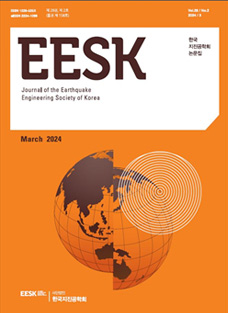![]() Journal Search Engine
Journal Search Engine
ISSN : 2234-1099(Online)
DOI : https://doi.org/10.5000/EESK.2012.16.3.013
지반-구조물 상호작용을 고려한 기초모델링
Foundation Modeling Considering the Soil-Structure Interaction
Abstract
1. Introduction
When the response of the soil influences the motion of the structure and the response of the structure influences the motion of the soil, it is referred to as soil-structure interaction. For highly flexible structural systems, foun-dation displacements and rotations may be inconsequenti-ally small relative to those in the building and can be safely neglected. However, for stiff structural systems, foundation deformations can represent a significant com-ponent of system flexibility. Ignoring foundation de-formation in such cases results in mischaracterization of dynamic properties such as the fundamental mode fre-quency and the damping ratio.(1),(2) As a result, it biases the engineering characterization of seismic demand.
There have been many efforts to make engineering guidelines for simple characterization of soil-structure-in-teraction(SSI) effects. One of the representative guide-lines is intended for use with force-based characterization of seismic design, as is commonly used for new building construction. These procedures were introduced by ATC(3) and an updated version is published in the NEHRP Recommended Provisions for Seismic Regulations for New Buildings and Other Structures.(4) The ATC and NEHRP procedures modify the fixed-base building period and damping ratio for the effects of foundation compliance. The modified vibration properties (Termed “flexible-base”) are used with the site design response spectrum to obtain the base shear for seismic design. The founda-tion-soil characterization inherent to these procedures consists of foundation springs for translational and rota-tional deformation modes that depend on a strain-com-patible soil shear modulus. The soil behavior is modeled as visco-elastic with no limiting shear stress.
The other guideline is intended for use with nonlinear static methods for structural performance assessment, as commonly used for building retrofit design.(5),(6) In this approach, the structural performance is characterized by a nonlinear static pushover curve. The shape of the pushover curve, as well as the distribution of member shears and moments, can be sensitive to foundation modeling. Accordingly, the aforementioned documents provide recom-mendations for modeling the foundation-soil system as elastic-perfectly-plastic elements positioned at each footing. The elastic portion is based on the real part of well-known impedance functions for foundation lateral trans-lation, vertical translation, and rocking. The plastic portion of the foundation springs is based on limiting soil pressures associated with bearing capacity failure(In the vertical direction) and sliding/passive failure(In the lateral direction).
Those guidelines are typically based in large part on representing the soil-foundation interaction in terms of elastic impedance functions that describe stiffness and damping characteristics. Such approaches are not able to capture the nonlinear behavior at the foundation level, which may involve formation of a temporary gap between the footing and soil, the settlement of the foundation, sliding, or energy dissipation from the hysteretic effects. A new research(7) proposed Beam-on-Nonlinear-Winkler-Foundation (BNWF) model to overcome those shortcomings. The BNWF model consists of a system of closely spaced independent nonlinear inelastic springs that are capable of capturing gapping and radiation damping. Vertical springs distributed along the base of the sides of the footing capture the resistance to sliding.
Additional researches are required to provide further insight into nonlinear foundation-soil interaction and the benefits of performing the type of simulations enabled by BNWF model. The first issue to be solved is that this sophisticated model needs too much work to apply to practice. Currently, BNWF is available for 2-D analysis and the process still requires quite a work although simpler than previous suggested methods. Moreover, when it’s developed to the 3-dimensional analysis, more complicated process is expected. It may raise a cost problem in design process. Second, the performance of this model against full-scale building has not been verified, especially under strongly shaken condition. Therefore, this model needs to be checked if it is applicable to make a global building model considering soil-structure interaction for system identification purpose.
The primary object of this research is to evaluate the effects of soil-structure interaction on identified modal frequencies. To achieve the goal, a high-fidelity and low order BNWF model is developed. The feasibility of the model is examined using measured data from the Cal(IT)2 building (See Figure 1).
 <Fig. 1> Cal(IT)2 Building in UC Irvine Campus
<Fig. 1> Cal(IT)2 Building in UC Irvine Campus
In Cal(IT)2 building and in its foundation soil, 43 force-balanced accelerometers were installed during the construction. Each floor is instrumented with at least five sensors to capture the longitudinal, transverse, and torsional vibration modes. Sensors in vertical direction were mounted on shear walls at the ground level and the roof level to monitor the rocking motion of the structure. What makes this building unique is that 12 sensors were installed in the free-field and deep onto the bedrock, in addition to those on the building structure. This makes it possible to better understand the whole soil-structure system. The down-hole sensors are 3 m deep and the free-field sensors are approximately 10 m away from the structure.
2. Soil Condition at Cal(IT)2 Building Site
 <Fig. 2> Soil strain and Shear Modulus Curves
<Fig. 2> Soil strain and Shear Modulus Curves
During the earthquake ground motions, soil starts to move and as a result, the modal frequencies of the soil-structure system decreases. This is due to the change in the shear modulus of the foundation soil during the earthquake, which can be examined by the strain history of the foundation soil. The displacement time history is obtained by double integration of the foundation and the down-hole acceleration measurements. The soil strain history is determined by dividing the relative displacement with the depth of the soil layer. Figure 2 shows the horizontal strain history of the foundation soil during Yucaipa Earthquake in 2005. It informs that the decrease in the shear modulus of the soil during the event is in the order of 20% compared to its original value. The soil shear velocity υs is defined as

where G is shear modulus, and ρ is dry density of soil.
From geotechnical report, it was found that the soil beneath the foundation is medium clay with shear wave velocity of 1269.7 ft/sec(=387.0 m/sec). The average dry density of the soil is 112.6 lb/ft3(=1803.7 kg/m3). Therefore, the initial shear modulus of soil is

 <Table 1> Effective Shear Modulus Ratio (G/Go)
<Table 1> Effective Shear Modulus Ratio (G/Go)
Following ASCE-41 and FEMA-356 (Table 1), similar result can be obtained. At the site where Cal(IT)2 building is located (Latitude: 33.686887, longitude: -117.825348), the effective shear modulus is 79% of the maximum shear modulus. By Terzaghi-Meyerhof equation, the ultimate bearing strength of soil is calculated (Table 2).

 <Table 2> Dimensions of Cal(IT)2 Building Foundations and Bearing Strength (qult)
<Table 2> Dimensions of Cal(IT)2 Building Foundations and Bearing Strength (qult)
The capacity factors Nγ, Nc, Nq are varying according to soil properties and well known from many experi-mental studies. B is width of footing and Df is depth from the surface to the bottom of the footing. c is cohesion of soil, and γ is specific weight of soil. Shape factors are needed for correction of Nc and Nγ Nγ .
3. Foundation Modeling
3.1 Dynamic Parameters
A key step in current methods of dynamic analysis of SSI under seismic loading is to estimate the dynamic impedance functions associated with a rigid but massless function. However, application of computational methods to a specific engineering problem requires substantial expertise in idealizing the actual system, and entails significant data-preparation and computation expenses. As a practical alternative, several researchers have developed simplified methods, among them, Gazetas equations for shallow stiffness(8) are widely used because it adequately reflects following key characteristics of the foundation-soil system and excitation: (1) the shape of the foundation-soil interface; (2) the amount of embedment; (3) the nature of the soil profile; and (4) the mode of vibration and the frequencies of excitation. Following the formulas and charts, the resultant dynamic stiffness and dashpot coefficients of Cal(IT)2 building foundations are calculated. Direction and dimension notations are shown in Figure 3. Here, as an example, the vertical stiffness of foundations is provided(Table 3).
 <Fig. 3> Direction & Dimension Notations of Footing
<Fig. 3> Direction & Dimension Notations of Footing
 <Table 3> Dynamic Stiffness of Cal(IT)2 Building Foundations in vertical Direction
<Table 3> Dynamic Stiffness of Cal(IT)2 Building Foundations in vertical Direction
3.2 Evaluation of Soil-Structure Interaction
As illustrated in Figure 4, the objective of system identification analyses is to evaluate the unknown properties of a system using a known input into, and output from, that system. For analyses of seismic response, the system has an unknown flexibility that generates a known difference between pairs of input and output strong motion recordings. As indicated in Figure 5, parameters describing the fixed-base system are evaluated from input/output pairs that differ only the structural deformation U. Likewise, para-meters describing the flexible base system are evaluated from strong motion pairs whose difference results from foundation flexibility in translation Uf and rocking θ, as well as structural flexibility. A comparison of fixed-base and flexible-base modal parameters provides a direct quantification of SSI effects.
 <Fig. 4> System Identification Problem
<Fig. 4> System Identification Problem
 <Fig. 5> Inputs and Outputs
<Fig. 5> Inputs and Outputs
In Cal(IT)2 building, in total 43 force-balanced accelero-meters were installed, but not for measurement of θ. Introducing vertical measurements at each side of the building U4 and U5, θ=(U4-U5)/(Width of building).
Three cases of base fixity are of interest in analyses of SSI: (1) Fixed-base representing only the flexibility of the structure; (2) Flexible-base representing the combined flexibility of the complete soil-structure system; and (3) Pseudoflexible-base representing flexibility in the structure and rocking in the foundation.(2) Using discrete time filter(DTF), transfer functions were obtained as Figure 6 for Yucaipa Earthquake.(9)
 <Fig. 6> Transfer Function for Yucaipa Earthquake
<Fig. 6> Transfer Function for Yucaipa Earthquake
It was observed that under earthquake excitations, the identified modal frequencies increase as the modeling of the building base changes from the flexible base to the fixed base(Table 4). This implies that the fixed base model only reflects the structural response, while the flexible base model involves not only the structural response, but also the swaying and rocking motions. It also implies that if the soil properties are permanently changed after an earthquake, the modal values will not be same even under the same earthquake.
 <Table 4> Identified Modal Parameters
<Table 4> Identified Modal Parameters
3.3 Beam on Nonlinear Winkler Foundation (BNWF) Model
This model is constructed with elastic beam-column elements to capture the structural footing behavior and zero-length soil elements to model the soil-footing behavior. As illustrated in Figure 7, inelastic material mod-els such as QzSimple 1, PySimple 1, and TzSimple 1 in OpenSees were implemented to simulate vertical load-displacement behavior, horizontal passive load-displace-ment behavior against the side of a footing, and horizon-tal shear-sliding behavior at the base of a footing, re-spectively.
 <Fig. 7> Example of BNWF Model
<Fig. 7> Example of BNWF Model
These three springs follow a nonlinear backbone resembling a bilinear behavior. PySimple 1 and QzSimple 1 have the capability to account for soil-foundation separ-ation via gap elements added in series with the elastic and plastic components. The elastic material captures the far-field behavior, while the plastic component captures the near-field permanent displacement. As an example, in the elastic range, the QzSimple 1 is expressed as

where q is load, kin is initial elastic(Tangent) stiffness, and z is the displacement.
The elastic region(yield point, q0 ) is defined by relating the ultimate load(qult) with a parameter Cr, i.e.,

In the nonlinear portion, the backbone curve is descri-bed by

where z0 is displacement at the yield point and z50 is displacement at which 50% of the ultimate load is mobilized, which is defined as

c and n are constitutive parameters controlling the shape of the post-yield portion. According to Matlock(10) and API(11), c=10, n=5, Cr=0.35 for soft clay, and c=0.5, n=2, Cr =0.2 for drained sand. The ultimate bearing capacity (qult) can be obtained by the Terzaghi theory(12). See Table 5 for more values.
 <Table 5> parameters for nonlinear spring
<Table 5> parameters for nonlinear spring
As an example, BNWF model for F10 footing in Cal(IT)2 building is considered. For simplicity, only vertical elastic and inelastic springs in vertical direction are designed for the applied moment in x-direction(Mx).
1) Stiffness intensity ratio, Rk=Kend/Kmid is 5, in this case.(13)
2) End length ratio, Re=Lend/L, is 0.16 per ATC-40, therefore, Lend=1.6 ft.
3) Spring spacing is 4.8 inch because minimum 25 springs are required along the footing length.
This model requires 25 plastic springs and the same number of elastic springs for one-strap model(2-D analysis). When it comes to the 3-dimensional analysis, 625 springs are needed. Moreover, a number of passive springs and sliding springs should be added considering horizontal loads. It is quite a number for just one footing. This issue raises a need of simplified method. A schematic plan and section for vertical spring design of F10 footing is illustrated in Figure 8. Though it’s not shown here for simplicity, a number of lateral and frictional springs should be added in real situation.
 <Fig. 8> Vertical Spring Design of F10
<Fig. 8> Vertical Spring Design of F10
3.4 State-Space Representation and Linearization
Rearranging Equation 6, the nonlinear tangent stiffness kp which describe the load-displacement relation within the nonlinear region of the backbone curve may be expressed as

As a test bed, 2-dimensional F3 footing receiving vertical load and moment is considered(Figure 9). For simplicity purpose, damping is not considered here.


 <Fig. 9> Backbone curve of Qzsimple1 for F3
<Fig. 9> Backbone curve of Qzsimple1 for F3
F3 footing has qz-spring at six points; two of them are located at increased end effect area. The stiffness matrix is given as(s is spring spacing, EI is footing property)

The equation of motion is  and let z1 =z(t), z2 =ż1 , z=[z1 , z2 ]T then it is described by the nonlinear differential equation of the form.(14)
and let z1 =z(t), z2 =ż1 , z=[z1 , z2 ]T then it is described by the nonlinear differential equation of the form.(14)

Now suppose the input is perturbed slightly to become ![]() and the initial state is also perturbed only slightly. So the corresponding solution may differ from z0(t) only slightly. In this case, the solution can be expressed as
and the initial state is also perturbed only slightly. So the corresponding solution may differ from z0(t) only slightly. In this case, the solution can be expressed as ![]() with
with ![]() small for all t. Under this assumption, we can expand Equation 4.3-6 as
small for all t. Under this assumption, we can expand Equation 4.3-6 as

For N-DOF’s system,

Neglecting higher power of ![]() and
and ![]() Equation 13 can be reduced to
Equation 13 can be reduced to

3.5 Application of LMI Model Reduction
The footing with Qzsimple 1 springs is divided into three parts; two end regions and one mid region. To reduce the order of this model efficiently maintaining its topology, Linear Matrix Inequality(LMI) reduction can be a useful tool. A matrix inequality

is called linear matrix inequality, where
F(x): affine function of the real vector X=[x1 , x2 , …, xn]T
F0 , F1 , …, Fn : real symmetric matrices
X is generalized controllability gramian and Y is generalized observability gramian if they satisfy the Lyapunov inequalities

Through the coprime factorization process, the structured gramians are obtained

where ![]() , and as a result, Equation (19) is obtained.
, and as a result, Equation (19) is obtained.

The controllability gramian and observability gramian shown in Equation (19) are in form of block diagonal matrices. They are intentionally separated into three blocks to keep the topology of each block. Now, each of gramians can be balanced without mixing the states with other blocks. Finally we have three balanced realization corresponding to their region as shown in Figure 10.
 <Fig. 10> LMI Model Reduction for Foundation
<Fig. 10> LMI Model Reduction for Foundation
4. Results and Conclusion
A 3-D finite element model of Cal(IT)2 building was developed with ETABS® and analysis performed to obtain an insight to the modal characteristics(Figure 11). Some material properties are summarized in Table 6.
 <Fig. 11> ETABS® model view from North-West side
<Fig. 11> ETABS® model view from North-West side
 <Table 6> Model Material Properties
<Table 6> Model Material Properties
The shear walls are modeled with “membrane” element to represent in-plane member stiffness. The cast-in-place walls and the slabs are modeled with “shell” element to represent out-of-plane bending stiffness as well as in-plane member stiffness.
Dimensions and material properties of members follow the as-built drawings. Simplified Gazetas boundary condition and fixed boundary condition are considered for comparison. The model has been updated according to measured vibration data. As expected, the model with fixed supporting condition shows higher natural frequencies but the gap is small(Table 7).
 <Table 7> Natural Frequencies
<Table 7> Natural Frequencies
The Yucaipa earthquake records are compared to the simulated acceleration and displacement using the FE model at sensor location 10-D of each level(Figure 12, Figure 13). The recorded and simulated acceleration response and amplitude match fairly well. In the future study, it will be interesting to observe how the updated supporting condition affects the simulation.
 <Fig. 12> General Plan and Sensor Location at point 10-D
<Fig. 12> General Plan and Sensor Location at point 10-D

 <Fig. 13> Recorded vs. Simulated Response
<Fig. 13> Recorded vs. Simulated Response
Acknowledgment
This research was supported by a grant(Code# ’09 R&D A01) from Cutting-edge Urban Development Program funded by Ministry of Land, Transport and Maritime Affairs of Korean government.
Reference
2.J. P. Stewart, et al., "Seismic soil-structure interaction in builidngs. I: Analytical aspects," Journal of Geotechnical and Geoenvironmental Engineering, Vol. 125, 26-37, 1999.

3.Applied Technology Council(ATC 3-06), Tentative provisions for the development of seismic regulations for buildings. Redwood City, CA, 1978.
4.Building Seismic Safety Council(BSSC), NEHRP recommended provisions for seismic regulations for new buildings and other structures. Washington, DC, 2004.
5.Federal Emergency Management Agency(FEMA), Prestandard and commentary for the seismic rehabilitation of building. Washington, DC, 2000.
6.American Society of Civil Engineering(ASCE 41-06), "Seismic rehabilitation of existing buildings," Reston, Virginia, 2006.
7.S. Gajan, et al., "Numerical models for analysis and performance-based design of shallow foundations subjected to seismic loading," University of California, Berkeley2008.
8.G. Gazetas, "Formulas and charts for impedances of surface and embedded foundations," Journal of Geotechnical Engineering, Vol. 117, 1363-1381, 1991.

9.S. Soyoz, "Health monitoring of existing structures," PhD Civil Engineering University of California, Irvine, Irvine, 2007.
10.H. Matlock, "Correlations for design of laterally loaded piles in soft clay," in 2nd Annual Offshore Technology Conference, Houston, Texas, 1970, pp. 577-594.

11.American Petroleum Institute(API), Recommended practice for planning, designing and constructing fixed offshore plathorms API recommended practice Seventeenth ed., 1987.
12.K. Terzaghi, Theoretical soil mechanics. New York: John Wiley, 1943.

13.C. W. Harden, et al., "Numerical modeling of the nonlinear cyclic response of shallow foundations," University of California, Berkeley 2005.
14.C. Chen, Linear system theory and design, Third ed. New York: Oxford University Press, 1999.

Frequency Bimonthly
Doi Prefix 10.5000/EESK
Year of Launching 1997
Publisher Earthquake Engineering Society of Korea



Online Submission
submission.eesk-j.or.kr
EESK
Earthquake Engineering Society of Korea







